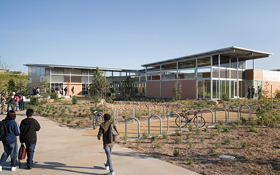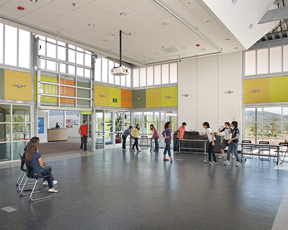Aiming ‘High’ With LEED Gold
 CHULA VISTA, Calif. — High Tech High, a charter school serving approximately 550 students in San Diego’s South Bay area, was recently awarded LEED Gold certification for its energy-efficient design and modular construction.
CHULA VISTA, Calif. — High Tech High, a charter school serving approximately 550 students in San Diego’s South Bay area, was recently awarded LEED Gold certification for its energy-efficient design and modular construction.Design firm Studio E and general contractor BYCOR, both of San Diego, worked with Williams Scotsman, a Baltimore-based provider of modular buildings, to construct the high school’s eight buildings with 59 modular units. The buildings, which total 32,807 square feet, are connected by a steel canopy that adds an additional 12,645 square feet of covered areas.
The school features a variety of environmentally friendly materials, including dual-pane windows, acrylic skylights, and light fixtures with motion sensors. Several renewable and recycled materials were used during construction, including sealed lightweight concrete floors, a sprayed polyurethane roof, and Homasote 440-SoundBarrier structural board, which is a high-density fiberboard made of recycled newspapers. All materials were available locally.
“Skylights, view windows and clerestory translucent panels were choreographed on the building’s roof and walls to provide abundant daylight in every classroom, and to reduce eye strain during critical visual tasks,” says Christopher Gerber, director of facilities for High Tech High. “Noise transmission between spaces, ambient noise from mechanical systems, and reverberation times within classrooms were meticulously managed through careful wall window, and mechanical system detailing.”


The campus saves approximately 550,000 gallons of water per year compared to the EPA-1992 Baseline, achieving a water savings of 52.6 percent. In addition, the campus generates 165,852 kWh of electricity per year with a photovoltaic solar array. The system produces 75 percent of the school’s annual electricity demands.
“Through energy-efficient lighting and mechanical systems, as well as the photovoltaic solar array, the project lowers operating costs and reduces the demand on the community electrical grid,” Gerber says.
The modular construction helped created significant energy savings and allowed for the structure to be built faster, according to planners.
“By constructing in a sheltered factory facility, it made it much easier to ensure the specified adhesives, coatings, drywall, paints, etc., were used in the project,” Gerber says. “Modular construction also allowed the project site construction work to be done in parallel with much of the building construction, reducing the amount of on-site project time needed by the modular construction company. This on-site schedule reduction directly reduced the air, noise and traffic impacts for the local community.
The school features a permanent educational display in the lobby that details the sustainable attributes, student work, and project-specific sustainable design elements.
